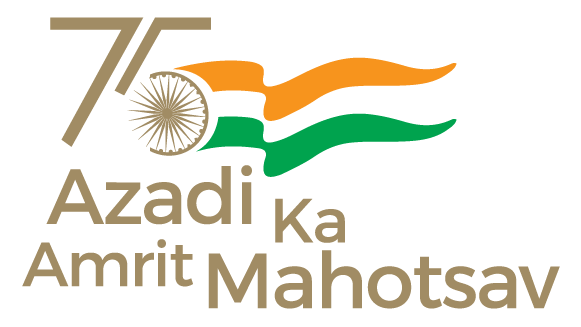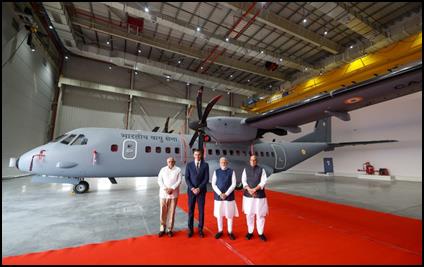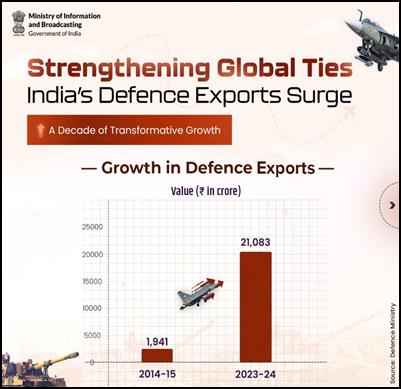Ministry of Defence

Marching Towards Atmanirbharta: India’s Defence Revolution
Domestic production hit ₹1.27 lakh crore in FY 2023-24, with exports growing 30x in a decade
Posted On: 29 OCT 2024 11:21AM by PIB Delhi
Introduction
 The recent inauguration of the TATA Aircraft Complex at the TATA Advanced Systems Limited (TASL) Campus in Vadodara, Gujarat, on October 28, 2024, marks a key milestone in India’s journey toward Atmanirbharta in defence. This facility, dedicated to manufacturing C-295 military transport aircraft, becomes the first private sector Final Assembly Line (FAL) for military aircraft in India, underscoring the government’s commitment to enhancing indigenous production capabilities. Under the program, 56 C-295 aircraft will be delivered, with the initial 16 arriving from Airbus in Spain and the remaining 40 produced domestically. This initiative exemplifies India’s shift toward self-reliance in defence manufacturing, aimed at strengthening operational readiness and reducing dependency on foreign imports.
The recent inauguration of the TATA Aircraft Complex at the TATA Advanced Systems Limited (TASL) Campus in Vadodara, Gujarat, on October 28, 2024, marks a key milestone in India’s journey toward Atmanirbharta in defence. This facility, dedicated to manufacturing C-295 military transport aircraft, becomes the first private sector Final Assembly Line (FAL) for military aircraft in India, underscoring the government’s commitment to enhancing indigenous production capabilities. Under the program, 56 C-295 aircraft will be delivered, with the initial 16 arriving from Airbus in Spain and the remaining 40 produced domestically. This initiative exemplifies India’s shift toward self-reliance in defence manufacturing, aimed at strengthening operational readiness and reducing dependency on foreign imports.
India’s commitment to Atmanirbharta in defence is further evidenced by its transformation from a major arms importer to an emerging centre for indigenous production. Driven by strategic government policies, this shift reached a landmark in FY 2023-24, with the Ministry of Defence reporting an unprecedented ₹1.27 lakh crore in domestic defence production. Once reliant on foreign suppliers, India now places a high priority on self-reliant manufacturing to meet its security needs, reinforcing its vision to strengthen national resilience and reduce dependency on external sources.

Rise in India’s Defence Production
India has achieved the highest-ever growth in indigenous defence production in value terms during Financial Year (FY) 2023-24, driven by the successful implementation of government policies and initiatives led by Prime Minister Shri Narendra Modi, focusing on attaining
Atmanirbharta. According to data from all Defence Public Sector Undertakings (DPSUs), other public sector units manufacturing defence items, and private companies, the value of defence production has surged to a record high of ₹1,27,265 crore, representing an impressive increase of approximately 174% from ₹46,429 crore in 2014-15.
Historically, India relied heavily on foreign countries for its defence needs, with about 65-70% of defence equipment being imported. However, this landscape has dramatically shifted, with around 65% of defence equipment now manufactured within India. This transformation reflects the country’s commitment to self-reliance in this critical sector and underscores the strength of its defence industrial base, which comprises 16 Defence Public Sector Units (DPSUs), over 430 licensed companies, and approximately 16,000 Micro, Small, and Medium Enterprises (MSMEs). Notably, 21% of this production comes from the private sector, bolstering India’s journey toward self-reliance.

As part of the Make in India initiative, major defence platforms such as the Dhanush Artillery Gun System, Advanced Towed Artillery Gun System (ATAGS), Main Battle Tank (MBT) Arjun, Light Combat Aircraft (LCA) Tejas, submarines, frigates, corvettes, and the recently commissioned INS Vikrant have been developed, reflecting the growing capabilities of India’s defence sector.
Consequently, the annual defence production has not only crossed ₹1.27 lakh crore but is also on track to reach a target of ₹1.75 lakh crore in the current fiscal year. With aspirations to achieve ₹3 lakh crore in defence production by 2029, India is solidifying its position as a global manufacturing hub for defence.

India’s Defence Exports Surge
 India’s defence exports have reached an all-time high, surging from ₹686 crore in FY 2013-14 to ₹21,083 crore in FY 2023-24, reflecting a remarkable increase of over 30 times in export value over the past decade.
India’s defence exports have reached an all-time high, surging from ₹686 crore in FY 2013-14 to ₹21,083 crore in FY 2023-24, reflecting a remarkable increase of over 30 times in export value over the past decade.
This achievement is driven by effective policy reforms, initiatives, and improvements in the ease of doing business implemented by the government, all aimed at attaining self-reliance in defence. Notably, defence exports also experienced a substantial growth of 32.5% over the previous fiscal year, rising from ₹15,920 crore.
India’s export portfolio boasts a diverse range of advanced defence equipment, including bulletproof jackets and helmets, Dornier (Do-228) aircraft, Chetak helicopters, fast interceptor boats, and lightweight torpedoes. A noteworthy highlight is the inclusion of ‘Made in Bihar’ boots in the Russian Army’s equipment, marking a significant milestone for Indian products in the global defence market and showcasing the country’s high manufacturing standards.

Currently, India exports to over 100 nations, with the top three destinations for defence exports in 2023-24 being the USA, France, and Armenia. According to Raksha Mantri Shri Rajnath Singh, the target is to further increase defence exports to ₹50,000 crore by 2029. This expanding international footprint underscores India’s commitment to becoming a reliable defence partner globally while bolstering its economic growth through enhanced defence production and exports.
Key Government Initiatives
In recent years, the Indian government has implemented a series of transformative initiatives aimed at bolstering the country’s defence production capabilities and achieving self-reliance. These measures are designed to attract investment, enhance domestic manufacturing, and streamline procurement processes. From liberalizing foreign direct investment (FDI) limits to prioritizing indigenous production, these initiatives reflect a robust commitment to strengthening India’s defence industrial base. The following points outline the key government initiatives that have been pivotal in driving growth and innovation in the defence sector.
- Liberalized FDI Policy: The Foreign Direct Investment (FDI) limit in the defence sector was raised in 2020 to 74% through the Automatic Route for companies seeking new defence industrial licenses and up to 100% through the Government Route for those likely to result in access to modern technology. As of February 9, 2024, ₹5,077 crore worth of FDI has been reported by companies operating in the defence sector.
- Budget Allocation: The allocation for the Ministry of Defence for the financial year 2024-25 is ₹6,21,940.85 crore, as part of the “Demand for Grant” presented in Parliament during the ongoing Budget Session.
- Priority for Domestic Procurement: Emphasis is placed on procuring capital items from domestic sources under the Defence Acquisition Procedure (DAP)-2020.
- Positive Indigenization Lists: Notification of five ‘Positive Indigenization Lists’ totalling 509 items of services and five lists of 5,012 items from Defence Public Sector Undertakings (DPSUs), with an embargo on imports beyond specified timelines.
- Simplified Licensing Process: Streamlining the industrial licensing process with a longer validity period.
- iDEX Scheme Launch: The Innovations for Defence Excellence (iDEX) scheme was launched to involve startups and Micro, Small, and Medium Enterprises (MSMEs) in defence innovation.
- Public Procurement Preference: Implementation of the Public Procurement (Preference to Make in India) Order 2017 to support domestic manufacturers.
- Indigenization Portal: Launch of the Self-Reliant Initiatives through Joint Action (SRIJAN) portal to facilitate indigenization by Indian industry, including MSMEs.
- Defence Industrial Corridors: Establishment of two Defence Industrial Corridors, one each in Uttar Pradesh and Tamil Nadu, to promote defence manufacturing.
- Opening Defence R&D: Defence Research & Development (R&D) has been opened up for industry and startups to foster innovation and collaboration.
- Domestic Procurement Allocation: Out of the total allocation of ₹1,40,691.24 crore under the Capital Acquisition (Modernization) Segment, ₹1,05,518.43 crore (75%) has been earmarked for domestic procurement in the Budget Estimates for 2024-25.
Conclusion
India’s journey toward Atmanirbharta in defence reflects a transformative shift from reliance on imports to becoming a self-sufficient manufacturing hub. The record achievements in domestic production and exports underscore the government’s commitment to enhancing national security and bolstering economic growth through robust defence initiatives. With strategic policies in place, a growing emphasis on indigenization, and a vibrant defence industrial base, India is poised to not only meet its own security needs but also emerge as a key player in the global arms market. The ambitious targets set for future production and exports signify a strong resolve to reinforce the country’s position as a reliable defence partner worldwide. As India continues to innovate and collaborate across sectors, it is well on its way to solidifying its status as a formidable force in global defence manufacturing.
References:
Santosh Kumar/ Ritu Kataria/ Saurabh Kalia
(Release ID: 2069090) Visitor Counter : 299




















